Our advantages
Better water quality with Pure Water
At Pure Water, we believe in the power of pure water and the positive impact it can have on your life. Our commitment to water purity, health and environmental awareness is reflected in every aspect of our products.

Quality and reliability
We are committed to quality and reliability. Our products are built to last, and our 1-year warranty provides additional peace of mind.

Healthier living
By removing harmful substances and chemicals, our filters provide you with water that is good for your body. Discover the benefits of being hydrated with pure water, and improve your well-being.

Environmental Awareness
With Pure Water, you are contributing to a cleaner planet. Less plastic waste and eco-friendly water treatment options make a difference for the environment and future generations.
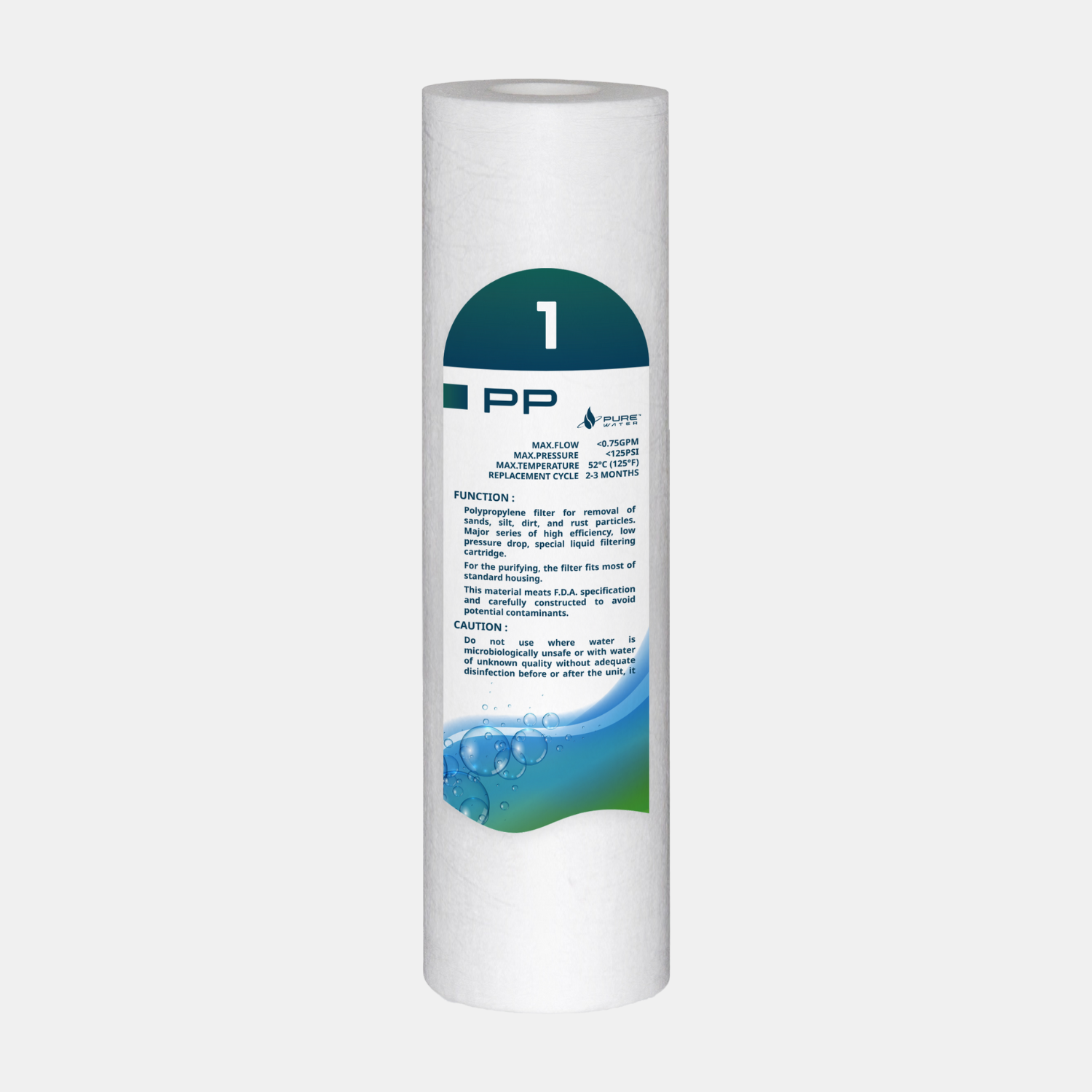

A PP filter, or polypropylene filter, removes particles and solid contaminants from water. The filter material, made of polypropylene fibers, traps impurities such as sand, mud, rust and fine particles, making the water clearer.
- Removal of sediment and suspended particles: PP filters remove impurities such as sand, mud, rust, fine particles and other suspended contaminants from water. This improves the clarity of the water.
- Filtration of coarser contaminants:They also serve as a pre-filter to remove coarser contaminants before the water goes through other filtration or purification steps. It is important to replace the PP filter regularly, as it becomes saturated over time and becomes less effective at removing particles and sediment.
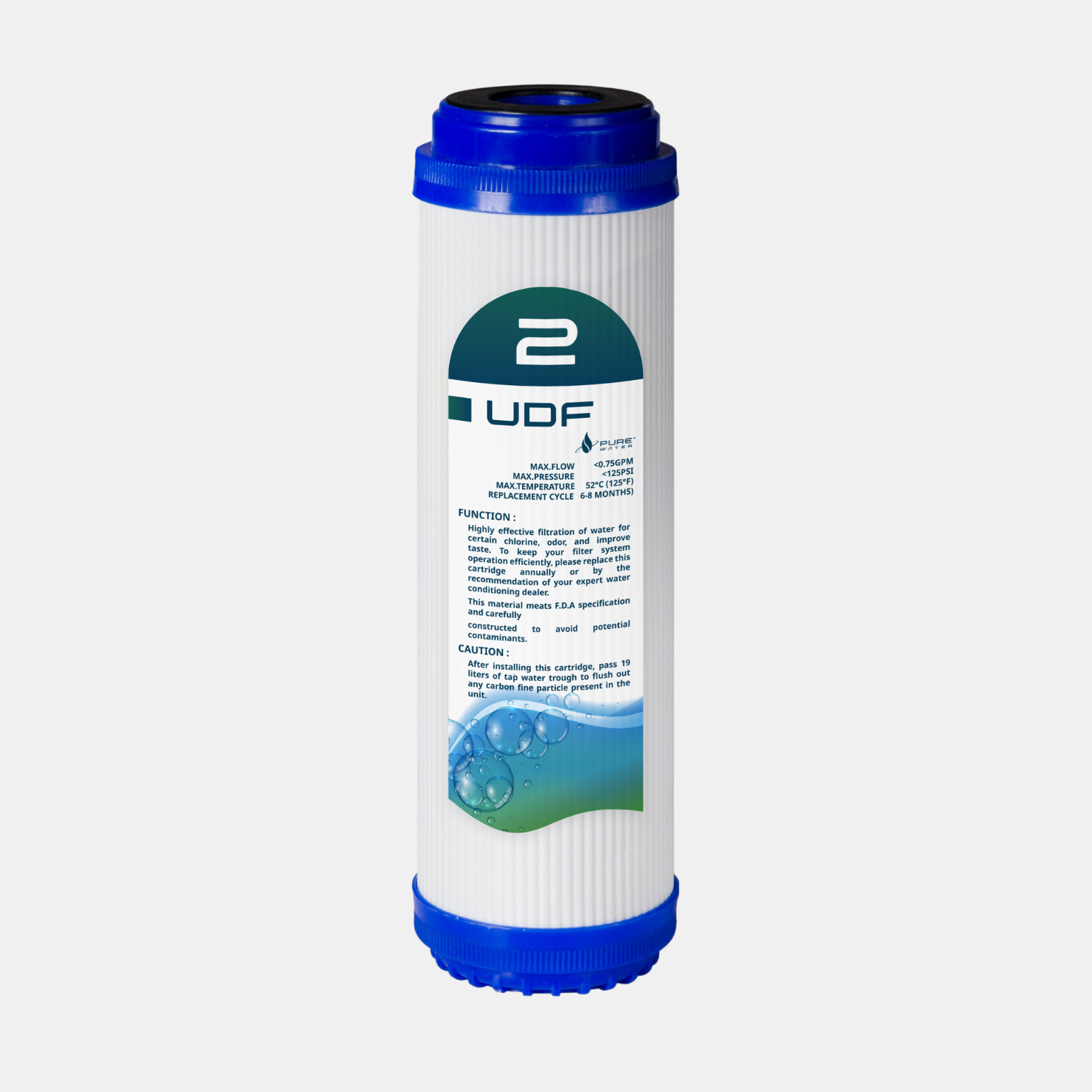

A UDF filter is a type of water filter commonly used to remove impurities and particles from tap water to improve the taste and quality of drinking water.
- Chlorine and taste improvement: UDF filters often remove chlorine and chlorine compounds from water, which can improve the taste and odor of water.
- Adsorption of organic contaminants: They can adsorb organic substances, such as some chemicals, odors and tastes, making the water cleaner and tastier.
- Particle filtration: UDF filters can also remove sediment and particles from the water, making the water clearer and free of suspended impurities.
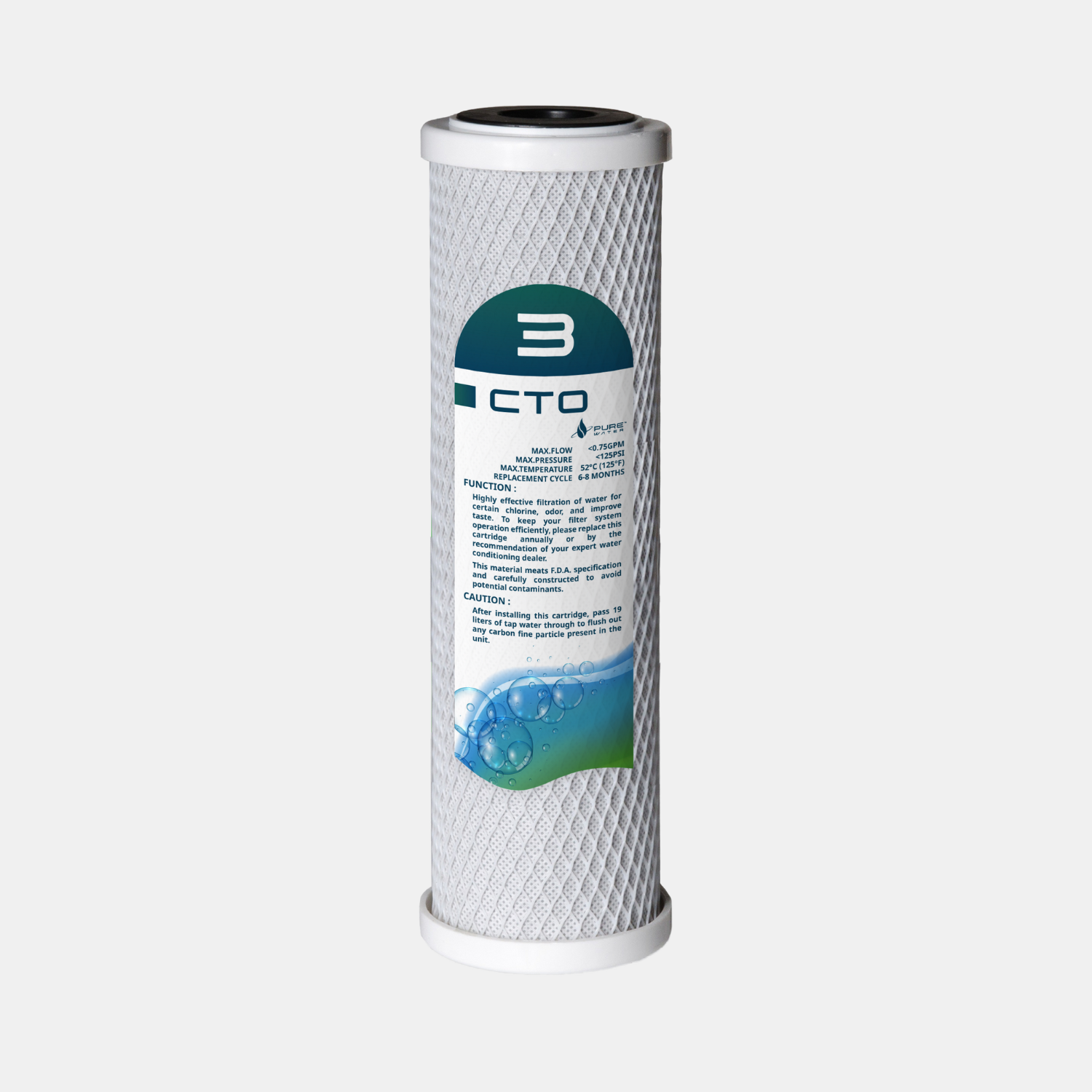

A CTO filter is specifically designed to improve the taste and odor of water by removing certain contaminants. CTO filters are effective in filtering:
- Chlorine removal:CTO filters eliminate chlorine and chlorine compounds often added to drinking water as disinfectants. This helps to improve the taste and odor of the water.
- Adsorption of organic contaminants: CTO filters absorb organic substances, leading to an improvement in taste and removal of unwanted odors and tastes in the water.


The RO membrane represents an advanced filtration step in water treatment systems. Some of the most prominent contaminants that can be successfully filtered by an RO membrane include:
- Salts and minerals:This membrane is particularly efficient at removing salts, minerals and even heavy metals such as sodium, calcium, lead and mercury.
- Organics: RO membranes have the capacity to adsorb organic compounds and various chemicals, including pesticides, herbicides and solvents.
- Bacteria and viruses: Microbial contaminants, such as bacteria and viruses, are thoroughly removed from the water.
- Sediment and particles:These membranes are able to effectively filter even small particles, sediment and other impurities.
- Taste and odor:In addition, RO membranes help improve the overall taste of the water and eliminate unpleasant odors.
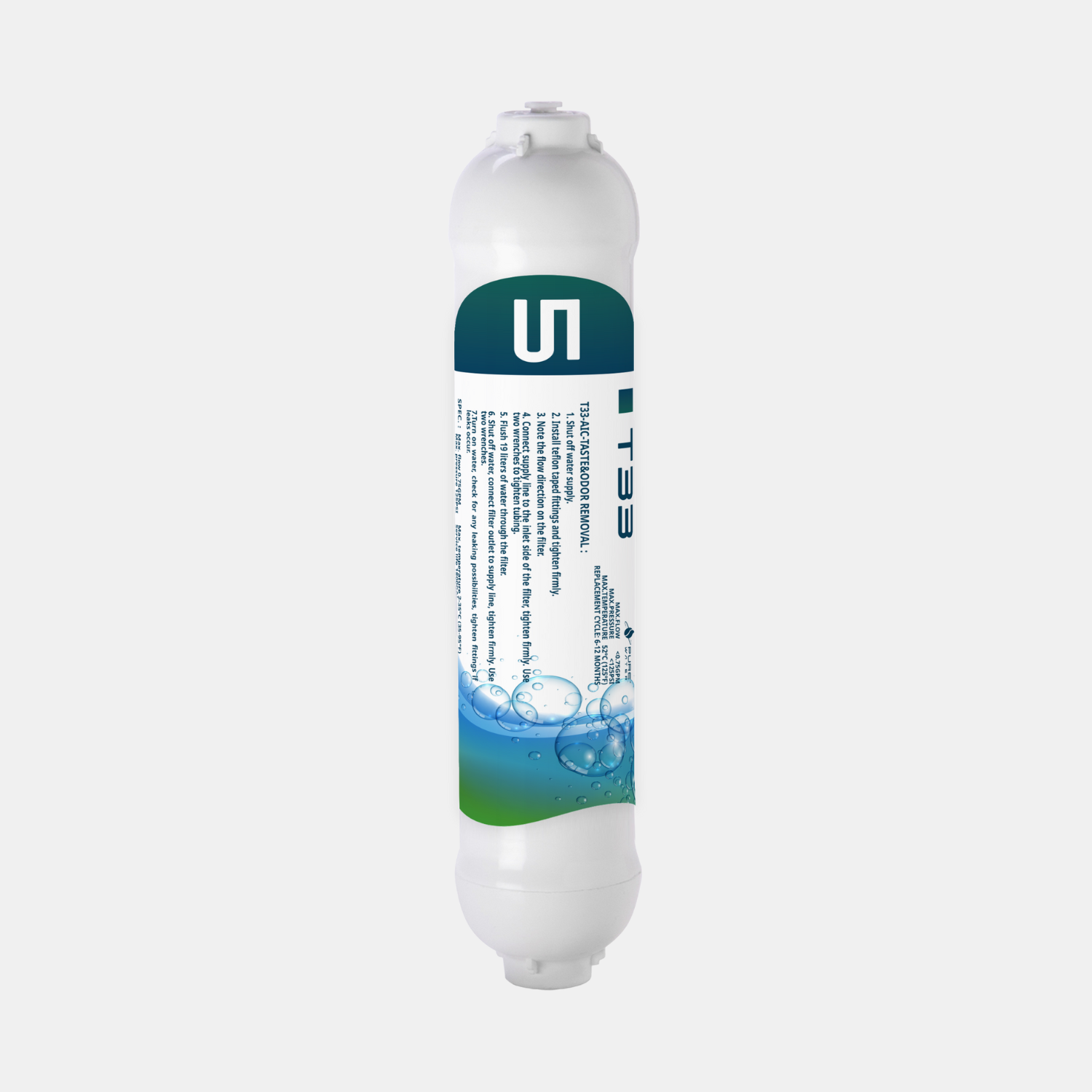

A T33 filter often referred to as an activated carbon is designed to remove specific contaminants from water. It concentrates primarily on:
- Chlorine and chlorine compounds: It eliminates chlorine, frequently used as a disinfectant in drinking water, improving the taste and odor of the water.
- Organic compounds: T33 filters adsorb organic compounds, such as certain chemicals, odors and tastes in the water.
- Residual sediments: Although it does not remove larger particles or sediments, such as sand or mud, it helps refine the water after previous filtration steps.
T33 filters are frequently used in water treatment systems to provide the final stage of purification and refinement. They enhance overall water quality by reducing unwanted tastes and odors, as well as removing residual organic contaminants
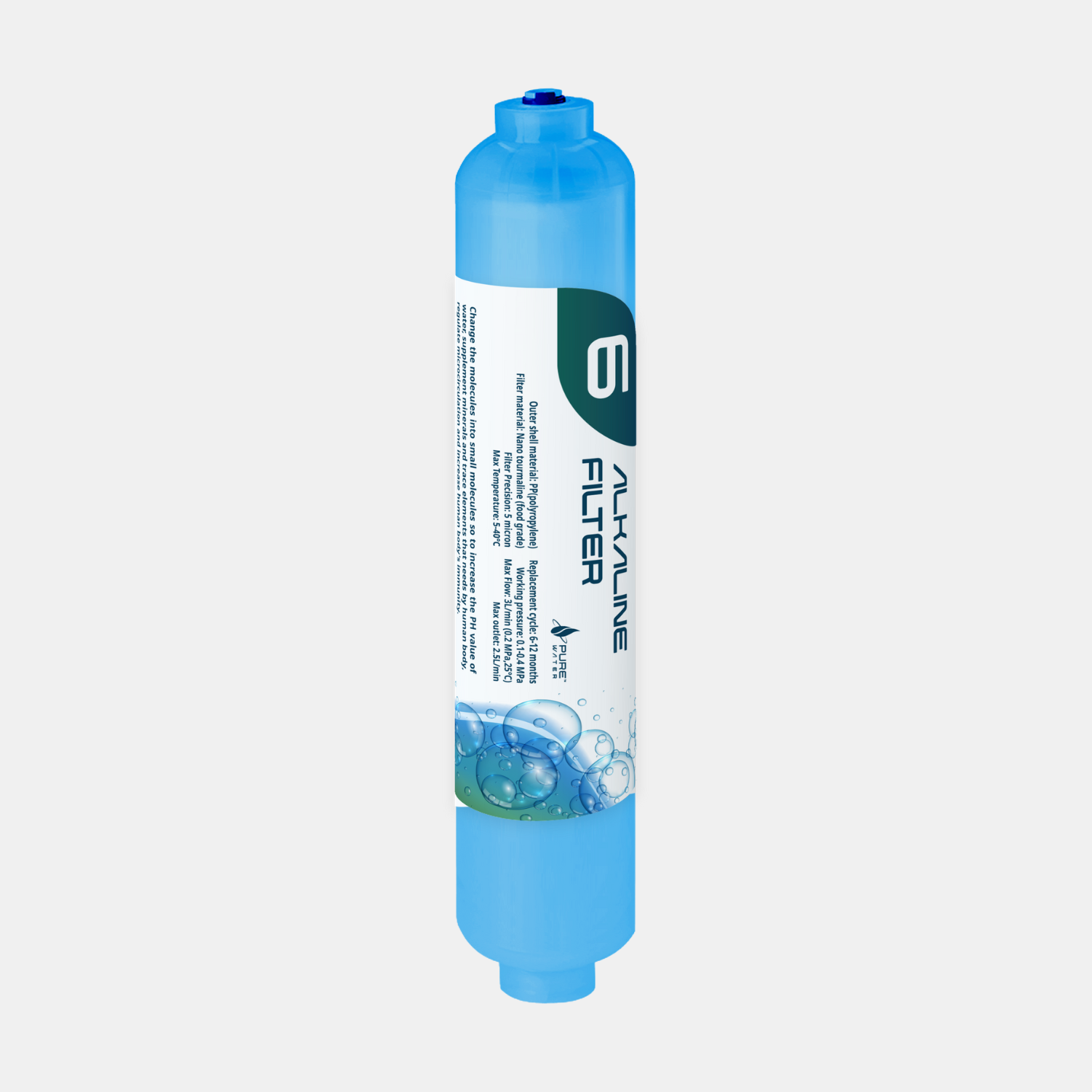

An alkaline filter, or also called an alkaline mineral filter, is a component of some water filtration systems. This type of filter is designed to raise the pH of water, making it more alkaline. Alkaline water typically has a pH value above 7.
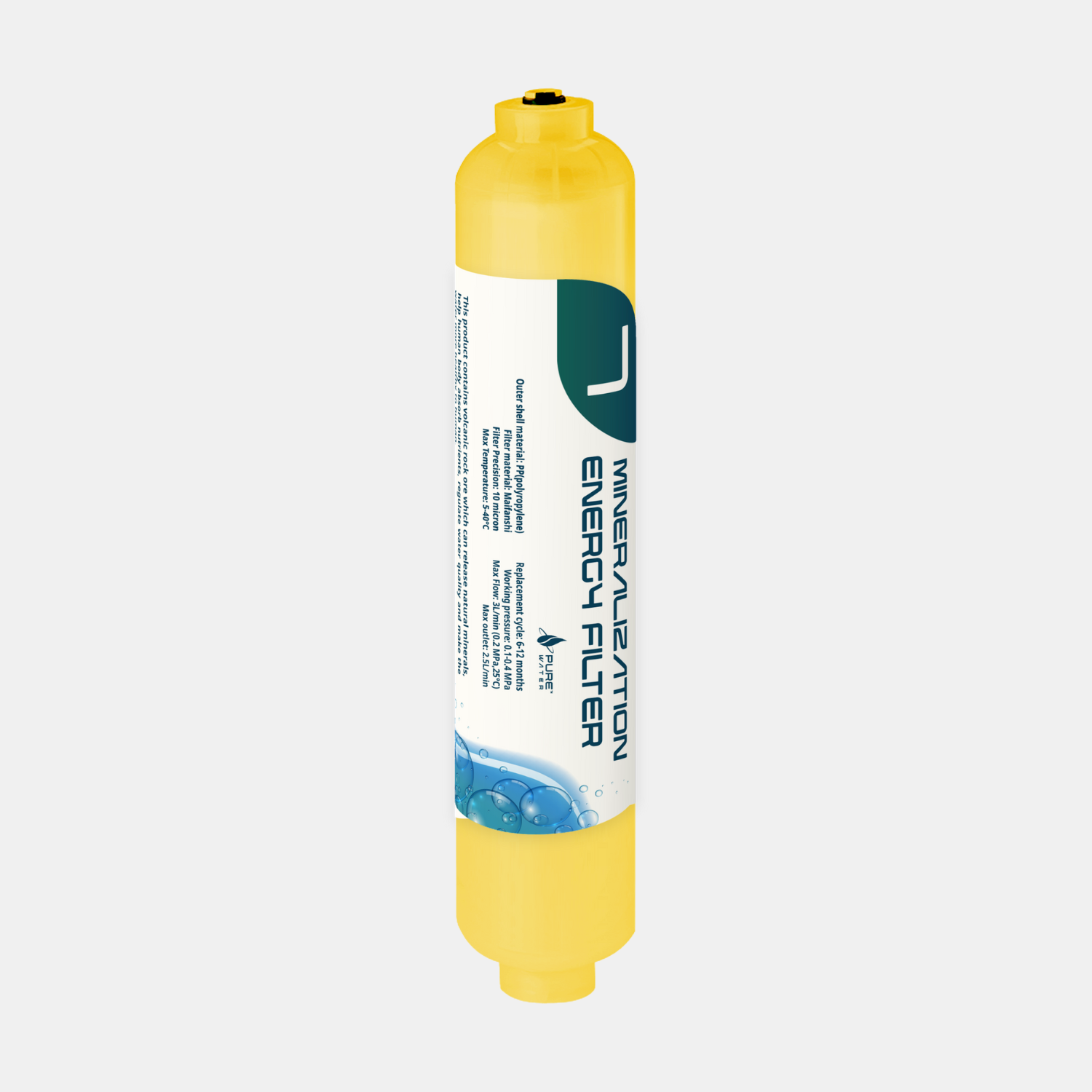

A mineral filter, also called a mineral balance filter, is a type of filter designed to add minerals to water while removing other unwanted contaminants. The purpose of these filters is to improve the taste and quality of the water by adding essential minerals that contribute to the mineral balance and acidity (pH) of the water.Mineral filters can add various minerals to the water, including calcium, magnesium and potassium. These minerals can improve the taste of the water and potentially provide some health benefits, such as balanced mineral intake.
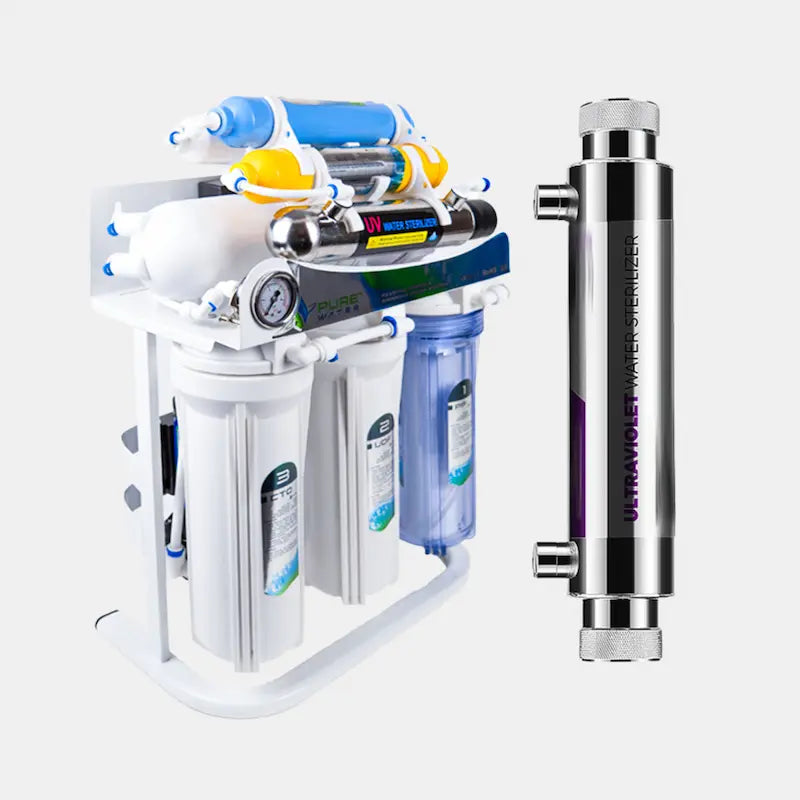

A UV (Ultraviolet) disinfection step in a water treatment plant uses ultraviolet radiation to deactivate or kill microorganisms, such as bacteria, viruses and fungi, in the water. Here is what a UV step does in a water treatment plant:
- Disinfection:Ultraviolet radiation of a specific wavelength is emitted by a UV lamp in a special chamber. As the water flows through this chamber, the microorganisms in the water are exposed to the UV radiation. This causes damage to the microorganisms' DNA and RNA, preventing them from reproducing and therefore rendering them harmless.
- Safe drinking water: The UV disinfection step ensures the water is free of pathogens, which is essential to meet drinking water quality standards and ensure water safety for consumers.
- Chemical-free: One of the advantages of UV disinfection is that it does not add chemicals to the water, such as chlorine. This not only disinfects the water, but keeps it free of chlorine residue or unpleasant tastes and odors often associated with chlorination.
It is important to note that UV disinfection specifically targets microorganisms and does not remove other impurities, such as chemicals or particles, from the water.

A PP filter, or polypropylene filter, removes particles and solid contaminants from water. The filter material, made of polypropylene fibers, traps impurities such as sand, mud, rust and fine particles, making the water clearer.
- Removal of sediment and suspended particles: PP filters remove impurities such as sand, mud, rust, fine particles and other suspended contaminants from water. This improves the clarity of the water.
- Filtration of coarser contaminants:They also serve as a pre-filter to remove coarser contaminants before the water goes through other filtration or purification steps. It is important to replace the PP filter regularly, as it becomes saturated over time and becomes less effective at removing particles and sediment.

A UDF filter is a type of water filter commonly used to remove impurities and particles from tap water to improve the taste and quality of drinking water.
- Chlorine and taste improvement: UDF filters often remove chlorine and chlorine compounds from water, which can improve the taste and odor of water.
- Adsorption of organic contaminants: They can adsorb organic substances, such as some chemicals, odors and tastes, making the water cleaner and tastier.
- Particle filtration: UDF filters can also remove sediment and particles from the water, making the water clearer and free of suspended impurities.

A CTO filter is specifically designed to improve the taste and odor of water by removing certain contaminants. CTO filters are effective in filtering:
- Chlorine removal:CTO filters eliminate chlorine and chlorine compounds often added to drinking water as disinfectants. This helps to improve the taste and odor of the water.
- Adsorption of organic contaminants: CTO filters absorb organic substances, leading to an improvement in taste and removal of unwanted odors and tastes in the water.

The RO membrane represents an advanced filtration step in water treatment systems. Some of the most prominent contaminants that can be successfully filtered by an RO membrane include:
- Salts and minerals:This membrane is particularly efficient at removing salts, minerals and even heavy metals such as sodium, calcium, lead and mercury.
- Organics: RO membranes have the capacity to adsorb organic compounds and various chemicals, including pesticides, herbicides and solvents.
- Bacteria and viruses: Microbial contaminants, such as bacteria and viruses, are thoroughly removed from the water.
- Sediment and particles:These membranes are able to effectively filter even small particles, sediment and other impurities.
- Taste and odor:In addition, RO membranes help improve the overall taste of the water and eliminate unpleasant odors.

A T33 filter often referred to as an activated carbon is designed to remove specific contaminants from water. It concentrates primarily on:
- Chlorine and chlorine compounds: It eliminates chlorine, frequently used as a disinfectant in drinking water, improving the taste and odor of the water.
- Organic compounds: T33 filters adsorb organic compounds, such as certain chemicals, odors and tastes in the water.
- Residual sediments: Although it does not remove larger particles or sediments, such as sand or mud, it helps refine the water after previous filtration steps.
T33 filters are frequently used in water treatment systems to provide the final stage of purification and refinement. They enhance overall water quality by reducing unwanted tastes and odors, as well as removing residual organic contaminants

An alkaline filter, or also called an alkaline mineral filter, is a component of some water filtration systems. This type of filter is designed to raise the pH of water, making it more alkaline. Alkaline water typically has a pH value above 7.

A mineral filter, also called a mineral balance filter, is a type of filter designed to add minerals to water while removing other unwanted contaminants. The purpose of these filters is to improve the taste and quality of the water by adding essential minerals that contribute to the mineral balance and acidity (pH) of the water.Mineral filters can add various minerals to the water, including calcium, magnesium and potassium. These minerals can improve the taste of the water and potentially provide some health benefits, such as balanced mineral intake.

A UV (Ultraviolet) disinfection step in a water treatment plant uses ultraviolet radiation to deactivate or kill microorganisms, such as bacteria, viruses and fungi, in the water. Here is what a UV step does in a water treatment plant:
- Disinfection:Ultraviolet radiation of a specific wavelength is emitted by a UV lamp in a special chamber. As the water flows through this chamber, the microorganisms in the water are exposed to the UV radiation. This causes damage to the microorganisms' DNA and RNA, preventing them from reproducing and therefore rendering them harmless.
- Safe drinking water: The UV disinfection step ensures the water is free of pathogens, which is essential to meet drinking water quality standards and ensure water safety for consumers.
- Chemical-free: One of the advantages of UV disinfection is that it does not add chemicals to the water, such as chlorine. This not only disinfects the water, but keeps it free of chlorine residue or unpleasant tastes and odors often associated with chlorination.
It is important to note that UV disinfection specifically targets microorganisms and does not remove other impurities, such as chemicals or particles, from the water.








How? What? Why?
Learn more about how our advanced water purification technology transforms your drinking experience and contributes to a cleaner planet.
How is the water filtered?
At Pure Water, we take your health and well-being seriously, and our filtration process is designed to deliver the purest drinking experience. Here's a brief overview of how we purify your water:
- Pre-filtration: Our process begins with thorough removal of larger impurities such as sediment and particles.
- Activated Carbon Filtration: Chlorine and organics are effectively absorbed, optimizing the taste and odor of your water.
- High performance RO filtration: The reverse osmosis membrane removes residual contaminants, including salts, metals and bacteria, for an absolutely pure base.
- Post-RO Adjustment: We perfect the mineral balance and pH, making your water not only pure, but healthy and balanced.
- Final Refinement: Our final filtration step eliminates any remaining impurities, allowing you to enjoy a glass of the highest quality water.
With Pure Water, you can be confident that your drinking water has been carefully treated to provide you with a refreshing and healthy experience. Choose purity, choose Pure Water.
What exactly is being filtered?
At Pure Water, we are committed to thorough purification, and our filtration process is designed to effectively remove a wide range of impurities. Here's an overview of exactly what our filtration system removes from your water:
- Sediment and Larger Particles: Our pre-filtration effectively captures sediment, sand and other coarser particles that affect water clarity.
- Chlorine and Organic Substances: Activated carbon filtration absorbs chlorine and organics, eliminating unpleasant odors and tastes.
- Heavy Metals and Minerals: Our advanced RO membrane removes heavy metals such as lead and minerals, keeping your water clean and safe.
- Bacteria and Microbes: The RO membrane provides protection against bacteria and microorganisms, keeping your water free of microbial contaminants.
- Final Refinement: The final filtration step eliminates remaining impurities, allowing you to enjoy a glass of water that is not only pure, but also of the highest quality.
With Pure Water, you can be confident that your drinking water has been purified to the finest detail, so you can enjoy water of the highest purity. Choose clarity, choose Pure Water.
Why Pure Water?
Pure Enjoyment
At Pure Water, we strive for perfection in purity. Our advanced filtration system is designed to purify every drop of water, allowing you to enjoy water free of impurities and taste-disrupting elements.
Health First
Your health is our priority. By removing harmful substances, bacteria and heavy metals, Pure Water not only provides a refreshing experience but also contributes to your overall well-being.
Sustainability in every drop
Choose sustainability with Pure Water. By investing in our filtration system, you avoid the need for disposable plastic bottles and contribute to a cleaner planet.
Tailored purity
Whether you use tap water, spring water or other water, our system adapts and ensures that you always experience the highest purity, regardless of the source.
Convenience at home
With Pure Water, you have instant access to high-quality drinking water in your own home. No hassle of lugging bottles or waiting for deliveries - pure convenience, always at your fingertips.
Discover the many benefits of Pure Water and take the step towards a healthier, purer and easier life today. Choose Pure Water, choose quality.
Een nieuwe kijk op waterkwaliteit
A new look at water quality
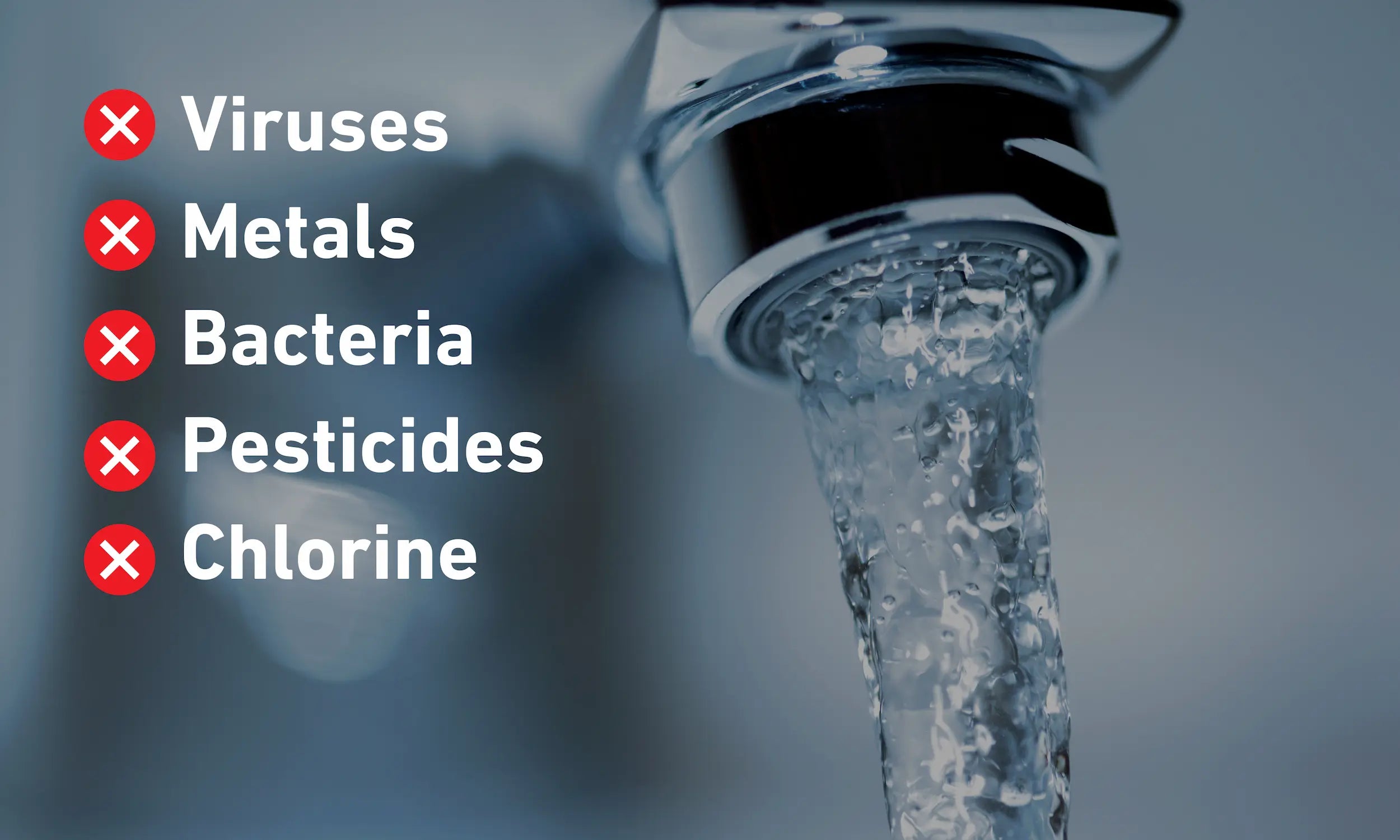
Tap water
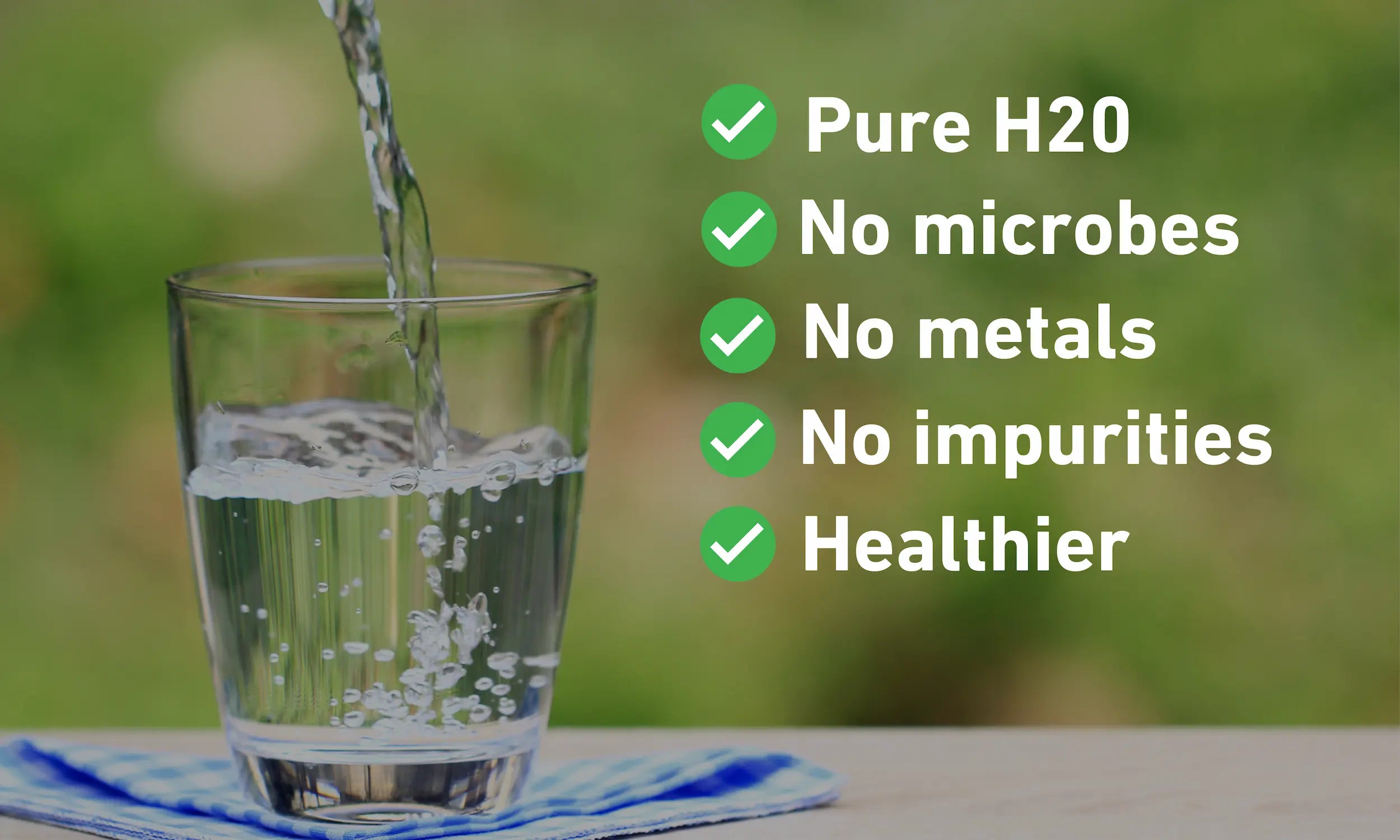
Pure Water
Contact with Pure Water
Contact us
Our team is ready to listen and help. Please do not hesitate to send us a message. Your questions and feedback are most welcome.

